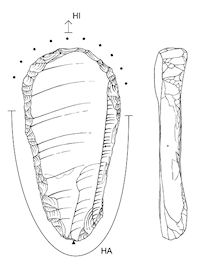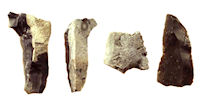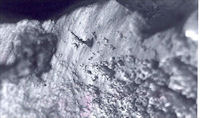

Figure 1a: Brandwijk: long end-scraper of imported flint with well-developed hide-working traces (drawing C. Dijkstra)
Figure 1b: Use-wear traces from hide-working (original magnification x200)
Brandwijk is situated to the east of Rotterdam in an old riverine landscape and dates to the Early Neolithic B and Middle Neolithic A (4600-4100 cal. BC) (Van Gijn and Verbruggen 1991). It is attributed to the southern group of the Swifterbant culture (Raemaekers 1999). The main habitation horizon, L50, is contemporaneous with the earlier phases of the Michelsberg culture. The inhabitants of Brandwijk at this time had a subsistence pattern characterised as 'extended broad spectrum': hunting, fishing and gathering, some domesticated animals but with only limited access to cereals. There is no evidence for local cereal cultivation at Brandwijk (Out 2008).


Figure 1a: Brandwijk: long end-scraper of imported flint with well-developed hide-working traces (drawing C. Dijkstra)
Figure 1b: Use-wear traces from hide-working (original magnification x200)
Brandwijk L50 has produced a large number of tools made of mined Rijckholt flint. This includes characteristic macrolithic tools of typical 'Michelsberg signature', such as large pointed blades, end-scrapers and triangular points (Fig. 1) (Raemaekers 1999; Van Gijn 2008a). No production waste of these exotic flint sources was found and it seems certain that they were imported as finished implements. Intriguingly, some tools from Brandwijk displayed traces of use that are normally only found on Michelsberg tools. This includes 'polish 10', a type of polish with attributes that resemble both hide- and plant-working traces but is probably related to neither (Schreurs 1992). Such traces are otherwise only found in Early and Middle Neolithic assemblages deriving from the Pleistocene uplands in the south-eastern Netherlands. Other Rijckholt implements display very well-developed hide-working traces of a variety rarely encountered in wetland assemblages (Fig. 1). Remarkably, although these tools were heavily used, they displayed no signs of resharpening. The conclusion must be that not only were these tools imported as finished products, they were imported as used tools.
The fact that these tools had a use-life before they were exchanged indicates that it is very likely that they were originally the possession of a specific person or group. This implies that the tool was, as an exchange item, commensurate with its previous owners or users. It is also highly significant that, after the exchange, the object was never used by the Brandwijk people: the objects were preserved in the state in which they were received and were never resharpened. This indicates that it was not so much the practical properties of the tool that were of concern to the recipients of these Michelsberg tools in the wetlands, but their value as exchange items. They were kept as tokens. It seems as if the inhabitants of the Brandwijk site wanted to affiliate or associate themselves, as it were, with the agriculturalists of the Michelsberg culture.


Figure 2a: Brandwijk: flakes and blades of locally available flint (photograph J. Pauptit, Leiden)
Figure 2b: Brandwijk: use-wear polish from plant processing seen on one of the locally produced blades (original magnification x200)
Besides the exotic Rijckholt tools, there is also a more locally based flint technology, making use of small available nodules that were subsequently knapped into flakes and blades (Fig. 2). These implements were predominantly used for plant processing and bone working and display a strong continuity with the tool use traditions of the Late Mesolithic sites of Hardinxveld (Van Gijn et al. 2001a; Van Gijn et al. 2001b).
© Internet Archaeology/Author(s) URL: http://intarch.ac.uk/journal/issue26/35/2.1.html
Last updated: Wed Jul 29 2009